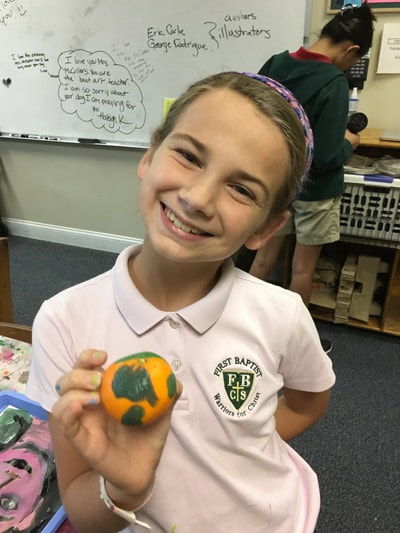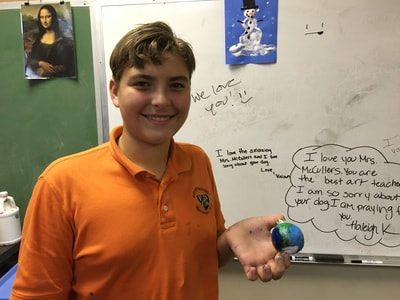|
For the past few weeks high school students have been painting and melting wax to create art. This is the first time I have explored this medium so it was a learning experience for all of us. Here are two of our completed pieces. Great job David and Kirsten!
When I first opened ArcGis I was overwhelmed—but, then I started exploring and within no time I was hooked. I started with a topographic base map of the area where I live. I added my house, the school I work at, the parks where I walk my dog, and an arrow that points to the beach. I included dotted lines from my house to the parks and a dash line from my house to where I work. I added layers that show the waterways, Intracoastal, bridges, and sea turtle nesting beaches. I have a feeling I will be spending a little more time on this website. Here is the link to my map: http://arcg.is/1PRorqf.
As I walked through my neighborhood to prepare for this assignment I was thinking about Denis Wood's talk from This American Life. I thought it was interesting that he would create a map of the houses that had Halloween pumpkins. I was also thinking about Stilgoe's chapter on Mail. I think that is why I had a collection of mailbox pictures when I got home. I noticed that most of the mailboxes on my side of the street were protected with poles because about once a year a group of teenagers ride through at night and hit the boxes with baseball bats. I found it interesting that only a few of the mailboxes on the other side of the street had poles to protect their boxes. I guess mine is the popular side for vandalism. I also noticed that none of the corner houses had their mailboxes on my street. They all chose the side street, even if their house faced my street. And there were a few houses with no mailboxes at all. I guess they got tired of replacing their mailboxes and now have P.O. Boxes at the post office. My symbolic map represents the mailboxes along my walk. The ones with stars are protected mailboxes. The spaces with numbers represent houses with no boxes. The empty spaces represent houses with boxes on the side streets. The boxes follow my walk from the beginning of the street to Elm Terrace and then back up the other side.
References Glass, I. (Producer). (1998, September 4). Mapping #101 [Audio podcast]. Retrieved from http://www.thisamericanlife.org/radioarchives/episode/110/mapping Stilgoe, J. (1998). Outside lies magic: Regaining history and awareness in everyday places . New York: Walker and Company. Draw a map of the world on an orange using paint, ink or a marker. Take a picture of your orange. Now carefully peel your orange and take another picture of your orange peel projection. Eat your orange. This was my assignment for the class I am taking this semester through UF. When Mrs. Trense delivered a bag of clementines to my room I knew the middle school students would love this project! Although time did not permit everyone who participated to peel and eat, students had a great time creating.
Class Assignment: Mapping Experiment Peel Projection. Draw a map of the world on an orange using paint, ink or a marker. Take a picture of your orange. Now carefully peel your orange and take another picture of your orange peel projection. Eat your orange.. For this project I started with an ink pen. The ink didn’t work very well so I switched to markers and paint pens. Below are pictures of my orange "world."
The first project for Mapping & Place: use a part of your body to measure a room/space. Then, write a short paragraph detailing your system and how you decided on a particular scale. For 1 point extra credit, video yourself measuring and post your video. For this project I decided to measure the back porch with my feet in moccasins simply because I was reading through the lesson on my back porch and I had on moccasins. First, I moved a few things from the walls to make the process easier. Next, I measured my foot in the moccasin and discovered it equaled ten inches. I drew a sketch of the porch area and then walked around the perimeter, moccasin to moccasin, counting the steps and making notes on my sketch (included in the video). Finally, I figured out that my porch had a perimeter of 117.5 moccasins or 1,175 inches. |
AuthorBrenda McCullers Podcast LinksArchives
April 2024
Categories
All
|
- Blog/Home
- About Me
- Podcast
- Testimony
- Artist Portfolio
- Online Art Camp Sign-up
- Lesson Plans
- Online Art Camp
-
UF Classwork
- Art Education in Alternative Settings >
- Art & Global Diversity >
- Contemporary Issues in Art Education >
- Curriculum in Teaching Art >
- The Digital Image >
- Digital Studio: Mapping & Place >
- Globalization, Art, & Education >
- History of Teaching Art >
- Independent Study & Capstone >
- Research Methods >
- Sketchbook >
- Contact Me
- Links



















 RSS Feed
RSS Feed
